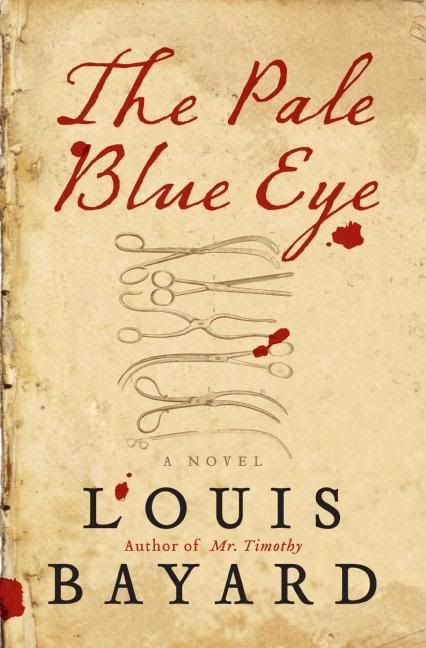 Gus Landor, a retired New York City constable is hired by West Point to investigate a cadet’s mysterious death in the autumn of 1831. During the course of the investigation, Landor employs the help of another cadet. That cadet, it turns out, is a young Edgar Allan Poe. And thus is the set-up for Louis Bayard’s latest novel The Pale Blue Eye.
Gus Landor, a retired New York City constable is hired by West Point to investigate a cadet’s mysterious death in the autumn of 1831. During the course of the investigation, Landor employs the help of another cadet. That cadet, it turns out, is a young Edgar Allan Poe. And thus is the set-up for Louis Bayard’s latest novel The Pale Blue Eye. Bayard expertly maps the rigors of cadet life in the 1830’s as well as the political reasons that the U.S. Military Academy wants to keep the investigation quiet. It’s subtle and comes out through Landor’s observations and conversations. Landor, recently widowed and fairly new to the upstate New York region that houses the Academy, serves as a wonderful pair of eyes and ears for the reader. He is a stranger to military life and his past occupation as a detective allows him to provide his tale with the details of the discipline and mind-set that his investigation runs up against.
Landor immerses himself in the investigation and Poe becomes an invaluable asset. But as a similar death follows, and Poe’s performance as a cadet and sleuth come into question, Landor tests the patience of Captain Hitchcock, the Commandant of Cadets. Hitchcock wants results and views Landor as hostile to a soldier’s life and too forgiving of Poe’s eccentricities. Most importantly, he concludes the investigation to be proceeding at a snail’s pace. And for a while it is.
There’s a certain elegance to how the story simmers and simmers in the mid-parts. The deaths remain at the forefront but move to the wings as we witness Landor and Poe’s bond grow stronger, first as kindred spirits, later as intimates – only in that formal mid-19th century American way, of course – where the pretense of the formal address of “Mr. Landor” and “Mr. Poe” are stripped away to the more familiar address of Landor and Poe. (In a humorous touch added by Bayard, Landor mentions this evolution in his narration, but outside of that mention, he always addresses Poe as “Mr. Poe” throughout the telling, even in the most private of drinking sessions.)
Once the plot does boil over, it does so wearing full Gothic regalia. The mystery opens up peculiar secrets and hard truths with family histories exposed that would have made the Bronte sisters proud. It’s a credit to Bayard’s plotting and writing style that such extravagances meld so well with the personal trajectories of Landor and Poe, both of whom are guarding secrets as well.
Poe works undercover and submits to Landor written reports that are at once informative missives about his findings as well as beautiful odes to whatever topic Poe is pondering (usually involving Miss Marquis, the young beauty he falls for) that includes over-the-top flourishes that only a young poet who doesn’t yet have the life experience to know what to write about would use. Bayard charmingly strikes the balance between the genius Poe will become and the young somewhat defensive eccentric he is at this time (at least by the U.S. Military Academy’s standards of behavior). Unlike some historical fiction that use a younger version of a notable figure, Bayard doesn’t use this as an opportunity to layout a template for Poe’s later acclaim (though Poe does write a poem with a character named “Leonore” and threatens a classmate in a manner not unlike Montresor in “The Cask of Amontillado”).
The Pale Blue Eye is the sort of historical fiction I like best. It doesn’t attempt to define a time with broad strokes or fill it up with empty foreshadowing of things to come. Rather, it uses character and human interaction to transport the reader to that time. From the bucolic descriptions of upstate New York to the reserved good manners at a dinner party, Bayard achieves in creating a wonderfully ripe world full of folly, cunning, obsession, and gallows humor. In other words, a world fit for the likes of Edgar Allan Poe.
No comments:
Post a Comment